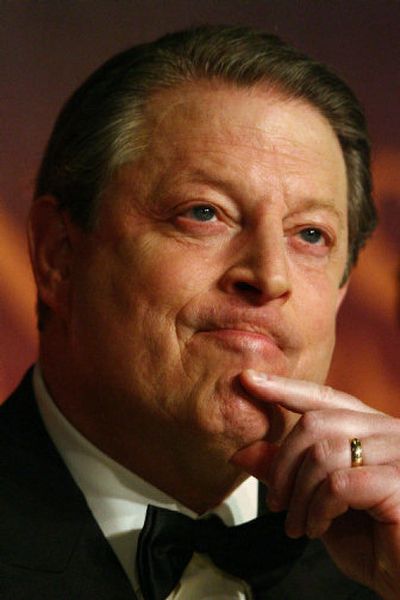Al Gore as a movie star

Al Gore, action hero.
Go ahead and laugh; the former vice president does, too. But with his new global-warming expose, “An Inconvenient Truth,” Gore may be the unlikeliest summer movie star since last year’s marching penguins.
“Truth” was a surprise hit at the Sundance and Cannes film festivals, and it has been playing to packed theaters since its debut three weeks ago. It was No. 11 on last weekend’s box office list, despite showing in only 122 theaters nationwide.
Indeed, Gore’s screen debut (which opened Friday in Spokane at AMC’s River Park Square 20) is shaping up to be this summer’s must-see water-cooler movie.
Liberal political junkies lament that he didn’t seem nearly as passionate, funny or charming when campaigning for president in 2000.
But “Truth” director Davis Guggenheim, whose credits include the TV shows “Alias,” “Deadwood” and “24,” says that while the heartbreak of losing the contested election caused a change in Gore, that has not been the only change.
“I think we’ve changed,” he says. “People are ready to hear Al in a different way now. The very nuanced, thoughtful answer – we’re hungry for that now.”
And Hollywood figured out a way to tap Gore’s fun side, making his message seem less like medicine.
Gore recently starred in a much-downloaded “Saturday Night Live” sketch as the “alternate universe” U.S. president. He posed with George Clooney and Julia Roberts as a Vanity Fair cover model.
Previously he played a cartoon version of himself in “Futurama” as a disembodied head in the 31st century, and he’s shooting a video for a Melissa Etheridge song featured in “Truth.”
“If you feel as passionately as I do about this message, you’re going to try to deliver it in every way that you can,” Gore says. “If that’s through a comedy skit on ‘Saturday Night Live,’ then so be it. If it’s as a disembodied head on a television cartoon, OK.
“But best of all is a movie made by people who know what they’re doing and can make it really entertaining.”
He calls himself a “reformed politician” who is not campaigning for anything except better fuel efficiency and a renewed awareness and respect for nature.
Although Gore resisted at first, Guggenheim persuaded him to talk in the film about personal reasons that inspired his environmentalism, like his youth spent on a Tennessee farm and his relationship with his children and late sister.
Guggenheim also made sure the movie had a sense of warmth and humor, avoiding a political attack like Michael Moore’s “Fahrenheit 9/11,” a movie he says “hardened a lot of hearts.”
Admirers of the film cross the political spectrum. Rolling Stone critic Peter Travers called it “scarier than anything in a dozen Japanese horror flicks.”
AintItCool.com critic C. Robert Cargill, writing under the pseudonym Massawyrm, described himself as a “lifelong, old school, traditionally conservative Republican” who nonetheless believed that Gore “manages to turn what could easily be a 100 minute episode-of-Nova’ snoozefest into a riveting conversation and argument on the need to reduce our CO2 emissions.”
Gore, sitting on a beachside bench in Santa Monica, jokes about his renaissance as a movie star.
“I used to have a framed cartoon of a goofy dog, with a snaggle-tooth, and it’s riding a tricycle with a little party hat on,” he says.
“And he’s riding on the stage of a grand opera house and three or four tiers of bedecked and bejeweled fans are clapping wildly. And the little dog is thinking, ‘I don’t know why they like this, but I’m going to keep doing it.’
“That’s me on the red carpet.”